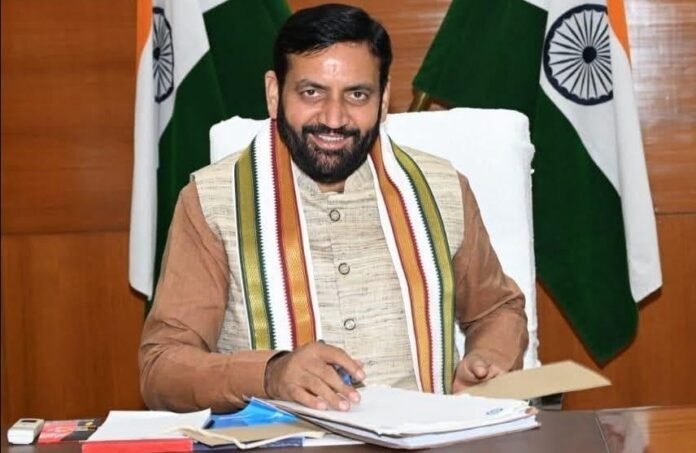Haryana, a state strategically positioned adjacent to the National Capital Region, is actively pursuing an agenda of accelerated development, particularly in infrastructure and urban expansion. The state’s budget for 2025-26, presented by Chief Minister and Finance Minister Naib Singh Saini on March 17, 2025, totals Rs 205,017 crore, marking a 13.70% increase over the previous year’s revised estimates. This fiscal blueprint places a strong emphasis on Industry and Urban Development, with allocations for these sectors more than doubling and town and country planning seeing a significant 39% increase. Agriculture and social welfare also received substantial boosts, with 36% and 28% increases, respectively. Notably, the budget speech announced the creation of a new Department of Future, envisioned as a hub for innovation and entrepreneurship, alongside the Sankalp Authority, dedicated to controlling the drug menace. However, a closer examination of the budget reveals a concerning fiscal reality: nearly all total revenue receipts, 99.46%, are consumed by committed expenditures. This includes 48.51% for debt repayment and interest, 25.02% for salaries, 12.91% for pensions, and 13.02% for social justice expenditure, which continues to grow. The remaining budget is largely managed through borrowings and negligible capital receipts. The projected revenue deficit (RD) is Rs 20,600 crore, with outstanding debt expected to reach Rs 3.53 lakh crore by the end of 2025. This places Haryana among the top 10 most indebted states, drawing parallels with the challenging financial situation of neighboring Punjab. The impressive headline growth figures and debt-to-GDP ratios, often presented as being within stipulated limits, may mask an unsustainable reliance on debt to fund even basic operations and welfare schemes, suggesting a potential “fiscal illusion” that warrants careful scrutiny.
The state’s aggressive push for infrastructure development and enhanced connectivity is evident across multiple fronts. The Delhi-Mumbai Expressway, spanning 1,350 kilometers, launched in 2019 and anticipated for completion in 2025, stands as India’s largest greenfield expressway. This monumental project is designed to drastically reduce travel time between Delhi and Mumbai and significantly improve logistics and trade across multiple states, including Haryana, with an estimated cost of ₹1,00,000 crore. Within Haryana itself, Karnal district is witnessing a flurry of activity, with high expectations for the completion and inauguration of several long-stalled projects in 2025. These include the Pandit Deen Dayal Upadhyay University of Health Sciences, a 138-acre facility with a 750-bed super-specialty hospital, administrative blocks, and colleges for nursing and physiotherapy, constructed at an estimated cost of Rs 761.51 crore. Additionally, an all-weather Olympic swimming pool and indoor sports complex in Sector 32, developed under the Smart City Mission at a cost of Rs 44 crore, is set to become operational. Upcoming projects in Karnal include the swift initiation of work on two elevated flyovers, a Rs 127.33 crore project aimed at alleviating traffic congestion, and the acceleration of the Karna Stadium redevelopment. While these infrastructure projects are critical for economic growth and attracting investment, their contribution to the state’s mounting debt must be considered. The success of these initiatives in generating sufficient economic returns to offset their costs and contribute to long-term revenue generation will be crucial for the state to avoid deepening its fiscal challenges.
A strategic shift towards industrial and urban expansion is clearly discernible in Haryana’s policy direction. The substantial increase in budget allocations for industries, commerce, and urban development , coupled with the establishment of a “Department of Future” focused on innovation and entrepreneurship , signals a deliberate intent to diversify Haryana’s economic base. This move aims to pivot away from traditional agriculture, leveraging the state’s strategic proximity to the National Capital Region to foster industrialization, urban centers, and a knowledge-based economy. If successful, this strategic reorientation could attract significant private investment, create non-agricultural employment opportunities, and boost the state’s GSDP. However, it also implies increased urbanization, potential environmental pressures, and the need for robust urban planning and social infrastructure to support growing populations. The success of this shift will ultimately depend on effective implementation and the state’s ability to attract and retain skilled labor, ensuring that the newfound economic dynamism is sustainable and inclusive.
Despite the ambitious development agenda, concerns regarding regional disparities persist. The 2025-26 budget primarily highlights investments in already well-off districts such as Yamunanagar, Ambala, Kurukshetra, Sonepat, Karnal, and Hisar. There is a noticeable paucity of new schemes for less developed districts like Nuh, Mahendragarh, Charkhi Dadri, and Bhiwani, with only isolated projects like a mustard oil mill or an aqua farm mentioned. Furthermore, a long-standing demand for a High Court Bench for South Haryana, a promise from the BJP’s 2014 manifesto, remains unaddressed. This omission not only inconveniences litigants but also incurs significant state expenditure as approximately 100 policemen from southern districts must travel to Chandigarh for court cases. This concentrated development in already advanced areas risks exacerbating existing regional inequalities, potentially leaving backward districts further behind. Such an approach, while possibly boosting overall state GDP, can lead to internal migration, strain on urban resources, and social discontent in neglected areas. This regional imbalance, compounded by the state’s increasing debt, presents a significant challenge to achieving inclusive growth and long-term social cohesion, with potential political ramifications in future elections.
In terms of governance, Haryana has been undertaking various administrative realignments and prioritizing public services. Recent updates include the release of lists of non-official members for District Public Relation and Grievances Committees on June 26, 2025, and the implementation of a Model Online Transfer Policy for government employees on the same date. Multiple transfers and postings of IAS and HCS officers were also reported between June 12 and June 23, 2025. Efforts to streamline bureaucracy and enhance efficiency are also reflected in the filling of posts in the Competition Commission of India on a deputation basis (June 25, 2025) and the uploading of vacant Group D posts on the HKCL portal (June 20, 2025). Additionally, the extension of the application deadline for the Protectorate of Emigrants Establishment Board (June 16, 2025) and the filling of Insurance Commissioner posts in the ESI Corporation (June 16, 2025) indicate ongoing administrative adjustments. These seemingly routine administrative updates are, in fact, foundational to the state’s ability to implement its ambitious budget and infrastructure plans. The emphasis on public grievance redressal and the Model Online Transfer Policy suggests a focus on transparency and accountability within the administrative machinery, vital for maintaining public trust and facilitating the state’s developmental aspirations.




